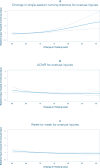How much running is too much? Identifying high-risk running sessions in a 5200-person cohort study
- PMID: 40623829
- PMCID: PMC12421110
- DOI: 10.1136/bjsports-2024-109380
How much running is too much? Identifying high-risk running sessions in a 5200-person cohort study
Abstract
Objectives: We explored whether a spike in running distance during a single session or over 1 week, compared with the preceding period, was associated with increased risk of running-related overuse injury.
Methods: Adult runners were recruited for an 18-month cohort study. Three training-related exposures were defined based on a relative change in running distance, using data collected via Garmin devices: (1) session-specific running distance relative to the longest distance run in the past 30 days; (2) 1-week period relative to the preceding 3 weeks using the acute:chronic workload ratio (ACWR); (3) 1-week period using a week-to-week ratio. Runners were categorised into one of four time-varying states: (1) regression, or up to 10% increase (reference); (2) 'small spike' between >10% and 30% increase; (3) 'moderate spike' between >30% and 100% increase; and (4) 'large spike' >100% increase. Outcome was self-reported overuse running-related injury. A multistate Cox regression model was used to estimate adjusted hazard rate ratios (HRR).
Results: Among 5205 runners (mean age 45.8 years, SD=10.4; 22% female), a total of 1820 (35%) sustained a running-related injury during 588 071 sessions. Significantly increased rates were identified for small spikes (HRR=1.64 (95% CI: 1.31 to 2.05, p=0.01)), moderate spikes (HRR=1.52 (95% CI: 1.16 to 2.00, p<0.01)) and large spikes (HRR=2.28 (95% CI: 1.50 to 3.48, p<0.01)) in single-session running distance. A negative dose-response relationship was observed for the ACWR. No relationship was identified for the week-to-week ratio.
Conclusion: A significant increase in the rate of running-related overuse injury was found when the distance of a single running session exceeded 10% of the longest run undertaken in the last 30 days.
Keywords: Athletic Injuries; Running; Sporting injuries; Sports medicine.
© Author(s) (or their employer(s)) 2025. Re-use permitted under CC BY-NC. No commercial re-use. See rights and permissions. Published by BMJ Group.
Conflict of interest statement
Competing interests: None declared.
Figures



References
-
- Shipway R, Holloway I. Health and the running body: Notes from an ethnography. Int Rev Sociol Sport. 2016;51:78–96. doi: 10.1177/1012690213509807. - DOI
-
- Scheerder J, Breedveld K, Borgers J. Running across Europe: the rise and size of one of the largest sport markets. Springer; 2015.
MeSH terms
LinkOut - more resources
Full Text Sources
Medical
Miscellaneous
